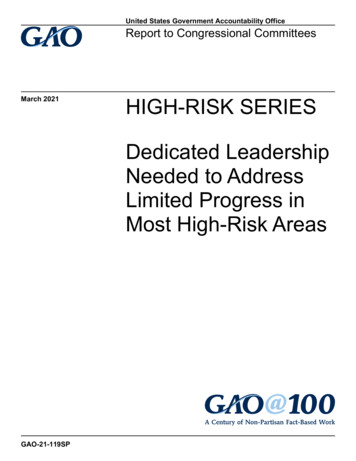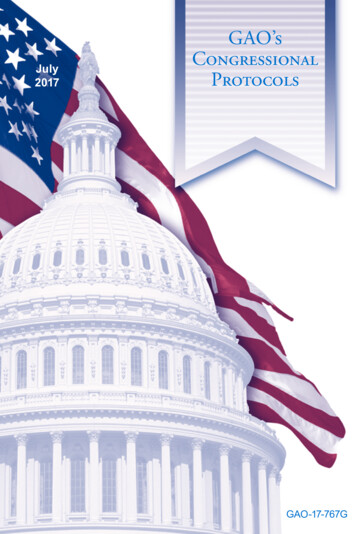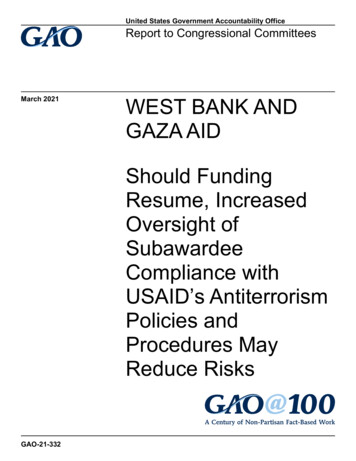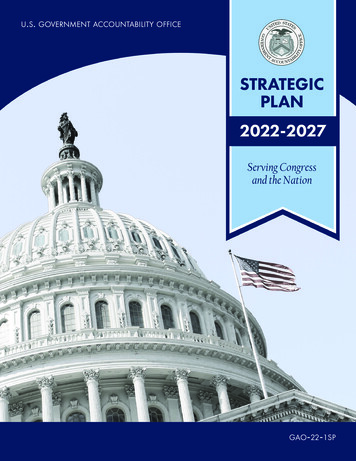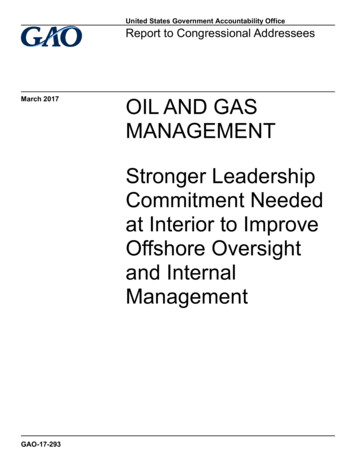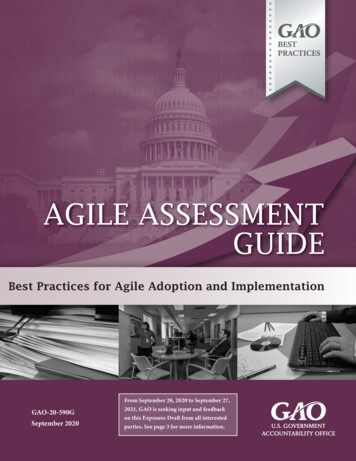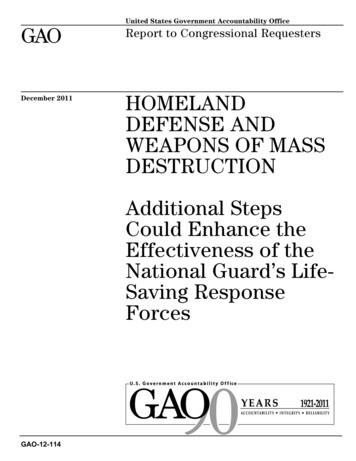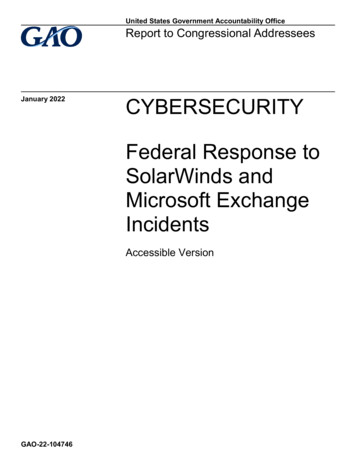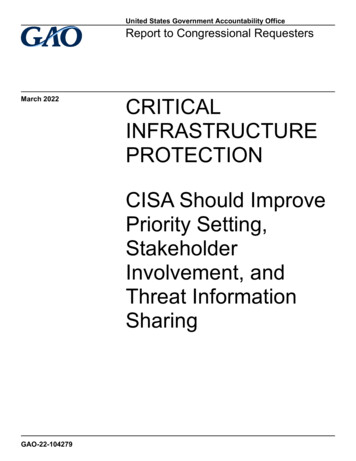
Transcription
United States Government Accountability OfficeReport to Congressional RequestersMarch 2022CRITICALINFRASTRUCTUREPROTECTIONCISA Should ImprovePriority Setting,StakeholderInvolvement, andThreat InformationSharingGAO-22-104279
FMarch 2022CRITICAL INFRASTRUCTURE PROTECTIONCISA Should Improve Priority Setting, StakeholderInvolvement, and Threat Information SharingHighlights of GAO-22-104279, a report tocongressional requestersWhy GAO Did This StudyWhat GAO FoundThe risk environment for criticalinfrastructure ranges from extremeweather events to physical andcybersecurity attacks. The majority ofcritical infrastructure is owned andoperated by the private sector, makingit vital that the federal governmentwork with the private sector, along withstate, local, tribal, and territorialpartners. CISA is the lead federalagency responsible for overseeingdomestic critical infrastructureprotection efforts.Through the National Critical Infrastructure Prioritization Program, theCybersecurity and Infrastructure Security Agency (CISA) is to identify a list ofsystems and assets that, if destroyed or disrupted, would cause national orregional catastrophic effects. Consistent with the ImplementingRecommendations of the 9/11 Commission Act of 2007, the program works toannually update and prioritize the list. The program’s list is used to inform theawarding of preparedness grants to states. However, nine of 12 CISA officialsand all 10 of the infrastructure stakeholders GAO interviewed questioned therelevance and usefulness of the program. For example, stakeholders identifiedcyberattacks as among the most prevalent threats they faced but said that theprogram’s list was not reflective of this threat. Further, according to CISA data,since fiscal year 2017, no more than 14 states (of 56 states and territories)provided updates to the program in any given fiscal year. Ensuring that itsprocess for determining priorities reflects current threats, such as cyberattacks,and incorporates input from additional states would give CISA greater assurancethat it and stakeholders are focused on the highest priorities.GAO was asked to review CISA’scritical infrastructure prioritizationactivities. This report examines (1) theextent to which the National CriticalInfrastructure Prioritization Programcurrently identifies and prioritizesnationally significant criticalinfrastructure, (2) CISA’s developmentof the National Critical Functionsframework, and (3) key services andinformation that CISA provides tomitigate critical infrastructure risks.GAO analyzed agency documentationand conducted interviews with criticalinfrastructure stakeholdersrepresenting the energy, water andwastewater systems, criticalmanufacturing, and informationtechnology sectors; six of 10 CISAregions; and six states to understandthe need for any improvements toCISA’s efforts, among other things.GAO selected these six states basedon population size and the amounts ofgrant awards received from DHS’sState Homeland Security Program.In 2019, CISA published a set of 55 critical functions of government and theprivate sector considered vital to the security, economy, and public health andsafety of the nation. According to CISA officials, this new National CriticalFunctions framework is intended to better assess how failures in key systems,assets, components, and technologies may cascade across the 16 criticalinfrastructure sectors. Examples of critical functions are shown below in CISA’sfour broad categories of “connect” (nine of the 55 functions), “distribute” (nine),“manage” (24), and “supply” (13).Examples of Cybersecurity and Infrastructure Security Agency (CISA) National CriticalFunctionsCISA is currently carrying out a process to break down each of the 55 nationalcritical functions (such as “supply water”) into systems (such as “public watersystems”) and assets (including infrastructure such as “water treatment plants”),as illustrated below.View GAO-22-104279. For more information,contact Tina Won Sherman at (202) 512-8461or shermant@gao.gov.United States Government Accountability Office
What GAO RecommendsExamples of Critical Infrastructure Systems and Assets That Support the National CriticalFunction “Supply Water”GAO recommends that CISA take thefollowing six actions and DHSconcurred: improve its process foridentifying criticalinfrastructure priorities tobetter reflect current threats; seek input from states thathave not provided recentupdates on identifying criticalinfrastructure; involve stakeholders in thedevelopment of the NationalCritical Functions framework; document goals andstrategies for the NationalCritical Functions framework; improve efforts to coordinatecybersecurity services; and share regionally specificthreat information.CISA plans to integrate the National Critical Functions framework into broaderprioritization and risk management efforts, and has already used it to inform keyagency actions. For example, CISA used the framework to analyze the impact ofCOVID-19 on critical infrastructure. Although CISA initiated the functionsframework in 2019, most of the federal and nonfederal critical infrastructurestakeholders that GAO interviewed reported being generally uninvolved with,unaware of, or not understanding the goals of the framework. Specifically,stakeholders did not understand how the framework related to prioritizinginfrastructure, how it affected planning and operations, or where their particularorganizations fell within it. In response, CISA officials stated that stakeholderswith local operational responsibilities were the least likely to be familiar with theNational Critical Functions, which were intended to improve the analysis andmanagement of cross-sector and national risks. Still, CISA officialsacknowledged the need to improve connection between the National CriticalFunctions framework and local and operational risk management activities andcommunications. In addition, CISA lacks an available documented frameworkplan with goals and strategies that describe what it intends to achieve and how.Without such a documented plan, stakeholders’ questions regarding theframework will likely persist.CISA offers physical and cybersecurity assessments to critical infrastructurepartners, but the agency’s 2020 reorganization resulted in challenges incommunicating and coordinating the delivery of some cybersecurity services.According to regional staff, their ability to effectively coordinate the cybersecurityservices that CISA headquarters delivered was impaired because of staffplacement following the reorganization. Specifically, staff conducting outreachand offering a suite of cybersecurity assessments to critical infrastructurestakeholders are located in regional offices, while CISA offers additional cyberassessment services using staff from a different division—the CybersecurityDivision—which operates out of headquarters. Addressing these communicationand coordination challenges can improve CISA’s cybersecurity support.CISA analyzes and shares threat information related to critical infrastructure;however, stakeholders reported needing more regionally specific information toaddress those threats. For instance, selected stakeholders that GAO spoke tosaid that CISA’s threat information helped them to understand the broader threatlandscape, such as threats to election security and COVID-19 response efforts.Almost half (12 of 25) of the stakeholders reported needing additional informationrelated to the threats specific to their regions and local infrastructure. Specifically,stakeholders told us that organizations in their regions were primarily concernedwith active shooters, chemical spills, or biological attacks and, thus, neededinformation that was applicable to those threats.View GAO-22-104279. For more information,contact Tina Won Sherman at (202) 512-8461or shermant@gao.gov.United States Government Accountability Office
ContentsLetter1BackgroundCISA and Critical Infrastructure Stakeholders Do Not Find theNCIPP UsefulLimited Understanding of National Critical Functions FrameworkMay Pose ChallengesCISA Cyber Services and Threat Information Sharing LackRegional FocusConclusionsRecommendations for Executive ActionAgency Comments and Our EvaluationAppendix I7162533414243Critical Infrastructure Sectors and Their Sector Risk ManagementAgencies47Examples of Selected Department of Homeland Security CriticalInfrastructure Prioritization Processes48Appendix IIIComments from the Department of Homeland Security49Appendix IVGAO Contacts and Staff Acknowledgments54Appendix IITablesTable 1: States Providing New Nominations and Updates to theNational Critical Infrastructure Prioritization Program, byFiscal Year (FY)Table 2: Examples of National Critical Functions Affected by the2021 Colonial Pipeline Company CyberattackTable 3: Examples of Cybersecurity and Infrastructure SecurityAgency (CISA) Security Assessments and Numbers ofAssessments Conducted in Fiscal Year (FY) 2020Table 4: Cybersecurity and Information Security Agency (CISA)Intelligence and Threat Information SharingPage i18303439GAO-22-104279 Critical Infrastructure Protection
Table 5: Selected Department of Homeland Security (DHS)Critical Infrastructure Identification Processes and Results48FiguresFigure 1: Examples of Critical InfrastructureFigure 2: Selected Critical Infrastructure Sectors and Their SectorRisk Management AgenciesFigure 3: Cybersecurity and Infrastructure Security Agency (CISA)Select Divisions and ResponsibilitiesFigure 4: Cybersecurity and Infrastructure Security Agency (CISA)Regions and Regional Office LocationsFigure 5: Cybersecurity and Infrastructure Security Agency (CISA)National Critical FunctionsFigure 6: Examples of Cybersecurity and Infrastructure SecurityAgency (CISA) National Critical FunctionsFigure 7: Examples of Critical Infrastructure Systems and AssetsThat Support the National Critical Function “SupplyWater”Figure 8: Cybersecurity and Infrastructure Security Agency (CISA)Selected Activities for the National Critical FunctionsFrameworkFigure 9: Critical Infrastructure Sectors and Their Sector RiskManagement AgenciesPage ii7810121526272847GAO-22-104279 Critical Infrastructure Protection
ITNCIPPPSASCCCybersecurity and Infrastructure Security AgencyCoronavirus Disease 2019Cybersecurity AdvisorDepartment of Homeland SecurityDepartment of EnergyFederal Emergency Management AgencyFederal Energy Regulatory CommissionGovernment Coordinating CouncilGPRA Modernization Act of 2010Information TechnologyNational Critical Infrastructure Prioritization ProgramProtective Security AdvisorSector Coordinating CouncilThis is a work of the U.S. government and is not subject to copyright protection in theUnited States. The published product may be reproduced and distributed in its entiretywithout further permission from GAO. However, because this work may containcopyrighted images or other material, permission from the copyright holder may benecessary if you wish to reproduce this material separately.Page iiiGAO-22-104279 Critical Infrastructure Protection
Letter441 G St. N.W.Washington, DC 20548March 1, 2022Congressional RequestersThe nation’s critical infrastructure consists of physical and cyber assetsand systems that are so vital to the United States that their incapacity ordestruction could have a debilitating impact on national security, publichealth and safety, or the economy. 1 Critical infrastructure provides theessential functions––such as supplying water, generating energy, andproducing food––that underpin American society. Protecting thisinfrastructure is a national security priority.The risk environment for critical infrastructure ranges from naturalhazards to cyberattacks, including acts of terrorism and insider threatsfrom witting or unwitting employees. Companies that own or operatecritical infrastructure have increasingly sought to gain efficiencies byconnecting their physical and cyber systems, and the convergencebetween these assets and systems creates new opportunities forpotential attackers.For instance, the 2021 cyberattack on the Colonial Pipeline Company—which led to the temporary disruption of gasoline and other petroleumproduct delivery across much of the southeast United States—illustratedhow the nation’s critical infrastructure assets and systems are ofteninterconnected with other systems and the internet, making them morevulnerable to attack. Because the majority of critical infrastructure isowned and operated by the private sector, it is vital that the public andprivate sectors work together to protect these assets and systems.The Department of Homeland Security (DHS) coordinates the overallfederal effort for national critical infrastructure protection and has statedthat prioritizing available resources to the most critical infrastructure canenhance our nation’s security, increase resiliency, and reduce risk. 2 Aspart of its responsibilities, DHS conducts critical infrastructure riskassessments and integrates relevant information and analyses to identify142U.S.C. § 5195c(e).2The Homeland Security Act of 2002 created DHS and gave the agency responsibilitiesfor coordinating national critical infrastructure protection efforts. See generally Pub. L. No.107-296, tit. II, 115 Stat. 2135, 2145.Page 1GAO-22-104279 Critical Infrastructure Protection
priorities for protective measures. DHS and other federal agencies; state,local, tribal, and territorial agencies and authorities; and the private sectormay implement these measures. The Cybersecurity and InfrastructureSecurity Agency Act of 2018 established the Cybersecurity andInfrastructure Security Agency (CISA) as an operational componentagency within DHS. 3 As the lead federal agency responsible forcoordinating the national effort to understand and manage risk to criticalinfrastructure, CISA has a critical responsibility to effectively coordinateand consult with its federal, state, local, territorial, tribal, and privatesector partners.Our prior work has identified DHS actions to identify and assess risk tocritical infrastructure. For example, we reported in 2013 that DHSchanged the National Critical Infrastructure Prioritization Program(NCIPP) list of the nation’s highest-priority critical infrastructure to makethe list entirely consequence based—that is, based on the effects that anevent would have on public health and safety, the national economy, orother areas. However, DHS had not identified the impact of thosechanges on users nor validated its approach. We recommended that DHScommission an external peer review of its approach, which DHS did. 4In 2014, we reported that DHS offices and components conducted orrequired thousands of critical infrastructure vulnerability assessments, butthat DHS needed to enhance the integration and coordination of theseefforts. 5 DHS implemented five of the six recommendations in our report,including our recommendation to better coordinate vulnerabilityassessments within DHS and other critical infrastructure partners. InOctober 2017, we also reported that DHS assesses each of the threeelements of risk—threat, vulnerability, and consequence—for the sectors3Cybersecurityand Infrastructure Security Agency Act of 2018, Pub. L. No. 115-278, § 2,132 Stat. 4168 (codified as amended at 6 U.S.C. § 652). Since its establishment, CISAhas been reorganizing offices and functions previously organized under the department’sNational Protection and Programs Directorate and aligning its new organizational structurewith its mission. See GAO, Cybersecurity and Infrastructure Security Agency: ActionsNeeded to Ensure Organizational Changes Result in More Effective Cybersecurity for OurNation, GAO-21-236 (Washington, D.C.: Mar. 10, 2021).4GAO,Critical Infrastructure Protection: DHS List of Priority Assets Needs to Be Validatedand Reported to Congress, GAO-13-296 (Washington, D.C.: Mar. 25, 2013).5GAO,Critical Infrastructure Protection: DHS Action Needed to Enhance Integration andCoordination of Vulnerability Assessment Efforts, GAO-14-507 (Washington, D.C.: Sept.15, 2014).Page 2GAO-22-104279 Critical Infrastructure Protection
we reviewed and that these assessments helped infrastructure ownersand operators take action to improve security and mitigate risks. 6You asked us to review CISA’s efforts to identify and prioritize criticalinfrastructure. This report addresses1. the extent to which CISA’s National Critical Infrastructure PrioritizationProgram identifies nationally significant critical infrastructure and whatchanges to the program, if any, are needed;2. CISA’s development of and stakeholders’ perspectives on theNational Critical Functions framework; and3. what key services and information CISA provides to mitigate criticalinfrastructure risks, and the extent to which the services andinformation meet stakeholder needs.Our review addresses these questions with a focus on two of CISA’smethodologies for identifying nationally significant critical infrastructure –the NCIPP and the National Critical Functions framework. We selectedthe NCIPP because it is a long-standing asset-based critical infrastructureprioritization model with direct ties to FEMA’s multi-billion dollarHomeland Security Grant Programs. We selected the NCF frameworkbecause it represents CISA’s new approach to risk analysis and criticalinfrastructure prioritization.For all three questions, we focused our review on four criticalinfrastructure sectors—energy, water and wastewater systems (water),critical manufacturing, and information technology (IT). To select thesesectors, we reviewed CISA’s Guide to Critical Infrastructure Security andResilience and DHS’s Sector Risk Snapshots and determined that thesefour sectors and their associated functions were strongly representedamong CISA’s list of National Critical Functions. CISA defines these asfunctions of government and the private sector so vital to the UnitedStates that their disruption, corruption, or dysfunction would have adebilitating effect on security, national economic security, national publichealth or safety, or any combination thereof. CISA has also designatedtwo of the four sectors (energy and water) as “lifeline sectors” or “lifelinefunctions,” meaning that their reliable operations are so critical that a6GAO,Critical Infrastructure Protection: DHS Risk Assessments Inform Owner andOperator Protection Efforts and Departmental Strategic Planning, GAO-18-62(Washington, D.C.: Oct. 30, 2017).Page 3GAO-22-104279 Critical Infrastructure Protection
disruption or loss of one of these functions would directly affect thesecurity and resilience of critical infrastructure within and acrossnumerous sectors. 7 The information we gathered is not generalizable toall 16 critical infrastructure sectors but does provide insight into how DHSidentifies and prioritizes critical infrastructure and the key services andinformation that CISA provides to mitigate risks as part of all threeobjectives. 8 From these four sectors, we met with officials from the federalSector Risk Management Agency. This agency is a federal department oragency designated by law or presidential directive with responsibility forproviding institutional knowledge and specialized expertise of a sector, aswell as leading, facilitating, or supporting programs and associatedactivities of its designated critical infrastructure sector in an all hazardsenvironment in coordination with DHS. 9 Specifically, we met with officialsfrom the Department of Energy (energy sector); Environmental ProtectionAgency (water sector); and CISA (for both critical manufacturing and ITsectors). We met with other relevant federal agencies, including theFederal Energy Regulatory Commission (FERC), on the basis of its rolein the energy sector; and the Federal Emergency Management Agency(FEMA), on the basis of its use of CISA risk information and support ofcritical infrastructure stakeholders. 10In addition to the four Sector Risk Management Agency officials notedabove, to address all three questions we interviewed a sample of federaland nonfederal critical infrastructure stakeholders. For each selectedsector, we met with officials from a relevant sector coordinating council orindustry association, which included owner-operators of critical assetsand members of their respective trade associations. We interviewed one7Thefour lifeline functions are transportation, water, energy, and communications.8The16 critical infrastructure sectors are Chemical; Commercial Facilities;Communications; Critical Manufacturing; Dams; Defense Industrial Base; EmergencyServices; Energy; Financial Services; Food and Agriculture; Government Facilities; HealthCare and Public Health; Information Technology; Nuclear Reactors, Materials, and Waste;Transportation Systems; and Water and Wastewater Systems.9See6 U.S.C. § 651(5). Sector Risk Management Agency responsibilities include therequirements to conduct sector specific risk assessments, coordinate with the departmenton national risk assessments, and provide the Director of CISA with critical infrastructureinformation on an annual basis. See 6 U.S.C. § 665d.10FERC is an independent agency that regulates the interstate transmission of electricity,natural gas, and oil. FEMA, within DHS, is part of a larger team of federal agencies; state,local, tribal, and territorial governments; and nongovernmental stakeholders that shareresponsibility for emergency management and national preparedness.Page 4GAO-22-104279 Critical Infrastructure Protection
CISA Protective Security Advisor (PSA) and one Cybersecurity Advisor(CSA) from each of the six out of 10 CISA regions we selected, for a totalof 12 interviews. 11 Our selected regions covered 31 states, two U.S.territories, and the District of Columbia, and are home to an estimated 70percent of the U.S. population, as of July 1, 2019. These regions wereselected to represent diversity in state population size, criticalinfrastructure (e.g., unique clusters of energy production, food production,manufacturing, etc.), and geography (e.g., coastal, interior). The results ofour interviews with PSAs and CSAs are not generalizable; however, theyrepresent more than half of CISA’s regions and provide useful insights oncritical infrastructure prioritization efforts. Last, we interviewed statehomeland security agency officials from five states—Colorado, Florida,Illinois, Texas, and Washington—and obtained written responses to ourquestions from California. We selected a mix of large- and medium-sizedstates with the highest levels of criticality within their respective CISAregions, based on their populations and the amount of grant awardsreceived from FEMA’s State Homeland Security Program. 12 Though theinformation we obtained is not generalizable to all states, it provided arange of state perspectives. Further, our state selection complementedour CISA regional selection, ensuring that we were able to interviewofficials from states outside our selection of CISA regions and, thus, tobroaden the range of national views we obtained.To evaluate the extent to which CISA’s NCIPP identifies nationallysignificant critical infrastructure and whether changes to the programwere needed, we obtained and analyzed infrastructure counts fromNCIPP lists finalized for fiscal years 2017 through May 2021. We usedthose lists to determine the total number of high-priority (Level 1 andLevel 2) assets by state and the change in distribution of high-priorityassets from year to year. We used these data to determine the extent towhich states provided updates to the program and the extent to which thenumber of assets on the lists has changed over time. We revieweddocumentation, including CISA’s guidance for nominating assets to the11CSAsand PSAs operate across CISA’s 10 regions. CSAs and PSAs we interviewedwere from Regions 2, 3, 4, 5, 7, and 8. We also interviewed the CISA RegionalCoordinator from Region 10 for contextual information on the regional coordinator role;however, this interview is not included in our overall total number of regional stakeholderinterviews, which include only the PSAs and CSAs.12DHS uses the population of each state, among other data, to allocate State HomelandSecurity Program and Urban Areas Security Initiative program grant funds - states withlarger populations represent a greater degree of criticality and receive higher amounts offunding.Page 5GAO-22-104279 Critical Infrastructure Protection
NCIPP list, and discussed quality assurance procedures with CISAofficials. We determined that the data were sufficiently reliable to describethe number of states that submitted data for the NCIPP list. Last, weinterviewed officials from a sample of federal and nonfederal criticalinfrastructure stakeholders, identified above, to discuss their roles in theNCIPP.To describe CISA’s development of the National Critical Functionsframework, we obtained and reviewed documentation on CISA’sprocesses for developing the National Critical Functions framework,including documentation of CISA’s outreach to the critical infrastructurecommunity. We compared these efforts with criteria set forth in the 2013National Infrastructure Protection Plan (National Plan). 13 Last, weinterviewed officials from a sample of federal and nonfederal criticalinfrastructure stakeholders, identified above, to discuss their roles incritical infrastructure identification and prioritization and their views onCISA’s current efforts.To evaluate the key services and information that CISA provides tomitigate risks to critical infrastructure, and the extent to which this supporthas met stakeholder needs, we examined DHS policies and guidancerelated to administering critical infrastructure security services andobtained information from CISA officials to determine how they prioritizeproviding services and outreach. In addition, we reviewed prior GAOreports and DHS Office of Inspector General reports to identify anychallenges that CISA has faced in providing security services and criticalinfrastructure information. We interviewed critical infrastructurestakeholders, as described above, to gather views on CISA support. Wealso met with officials from CISA’s National Risk Management Center,Integrated Operations Division, and the Cybersecurity Division tounderstand their processes for coordinating and providing securityservices and information to the regions. Additionally, we comparedCISA’s efforts to support critical infrastructure stakeholders with13Department of Homeland Security, National Infrastructure Protection Plan (Washington,D.C.: December 2006). DHS updated the 2006 National Plan in January 2009 to includegreater emphasis on resiliency; and National Infrastructure Protection Plan, Partnering toEnhance Protection and Resiliency (Washington, D.C.: January 2009). DHS updated the2009 National Infrastructure Protection Plan in December 2013 to emphasize theintegration of physical and cybersecurity into the risk management framework:2013National Infrastructure Protection Plan, Partnering for Critical Infrastructure Security andResilience (Washington, D.C.: December 2013).Page 6GAO-22-104279 Critical Infrastructure Protection
applicable coordination criteria in the National Plan and relevant statutoryprovisions. 14We conducted this performance audit from September 2020 to February2022 in accordance with generally accepted government auditingstandards. Those standards require that we plan and perform the audit toobtain sufficient, appropriate evidence to provide a reasonable basis forour findings and conclusions based on our audit objectives. We believethat the evidence obtained provides a reasonable basis for our findingsand conclusions based on our audit objectives.BackgroundCritical Infrastructure,Sectors, and AgencyPartnershipsThe nation’s critical infrastructure (examples of which are shown in fig. 1)refers to the systems and assets, whether physical or virtual, so vital tothe United States that the incapacity or destruction of them would have adebilitating impact on U.S. security, economic stability, public health orsafety, or any combination of these factors. 15Figure 1: Examples of Critical InfrastructureFederal law and policy establish roles and responsibilities for protectingcritical infrastructure. Presidential Policy Directive 21 and federal lawdescribe Sector Risk Management Agencies (formerly known as SectorSpecific Agencies) in the public sector as the federal departments oragencies, designated by law or presidential directive, that are responsible14Department1542of Homeland Security, 2013 National Infrastructure Protection Plan.U.S.C. § 5195c(e).Page 7GAO-22-104279 Critical Infrastructure Protection
for providing institutional knowledge and specialized expertise. 16 TheSector Risk Management Agencies are to lead, facilitate, and support thesecurity and resilience programs and associated activities of theirdesignated critical infrastructure sectors in an all hazards environment incoordination with DHS, among other duties.The directive identified 16 critical infrastructure sectors and designatedthe nine associated Sector Risk Management Agencies, which are listedin appendix 1. Figure 2 lists the four sectors we reviewed for this reportand their respective Sector Risk Management Agencies.Figure 2: Selected Critical Infrastructure Sectors and Their Sector Risk Management AgenciesAs part of the partnership structure, each sector has a governmentcoordinating council, consisting of representatives from various levels ofgovernment, and a sector coordinating council (SCC), consisting ofowner-operators of critical assets and members of relevant tradeassociations. The National Plan describes the voluntary partnershipmodel as the primary means of coordinating government and privatesector efforts to protect critical infrastructure. It provides a framework for16The White House, Presidential Policy Dir
partners. CISA is the lead federal agency responsible for overseeing domestic critical infrastructure protection efforts. GAO was asked to review CISA's critical infrastructure prioritization activities. This report examines (1) the extent to which the National Critical Infrastructure Prioritization Program currently identifies and prioritizes
